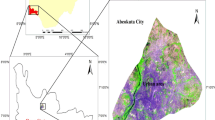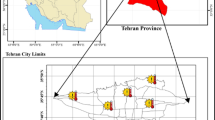Abstract
A spatial-temporal model with Model Maker tool is designed to retrieve Land Surface Temperature (LST) and to describe the changes of urban heat island, as well as urban development. Spectral Radiance, Brightness Temperature, NDVI, and Emissivity are first calculated from TM and ETM+, which are then used to compute LST by using Qin et al.’s mono-window algorithm. The LST is classified based on normalized statistical method, and the normalized heat images are computed between different times. Therefore, the urban heat changes can be shown in the map clearly and directly through an urban heat conversion matrix. Such a model has been applied in this study to obtain the urban heat conversion matrix of South China from 1990 to 2000. The results indicate that the LST increased areas mainly locate along the major roads in the eastern bank of the Pearl River, which is a result of speedy urban expansion and need to be noticed in the future.





Similar content being viewed by others
References
Carnahan WH, Larson RC (1990) An analysis of an urban heat sink. Remote Sens Environ 33:65–71
Dousset B, Gourmelon F (2003) Satellite multi-sensor data analysis of urban surface temperatures and landcover. ISPRS J Photogramm 58:43–54
Gillespie AR, Rokugawa S, Matsunaga T, Cothern JS, Hook SJ, Kahle AB (1998) A temperature and emissivity separation algorithm for advanced spaceborne thermal emission and reflection radiometer (ASTER) images. IEEE Trans Geosci Remote 36(4):1113–1126
Iqbal M (1983) An introduction to solar radiation. Academic Press, London, p 390
Irish RR (2000) Landsat 7 science data user’s handbook. National Aeronautics and Space Administration. http://ltpwww.gsfc.nasa.gov/IAS/handbook/handbook_toc.html. Cited 10 March 2003
Jimenez-Munoz JC, Sobrino JA (2003) A generalized single-channel method for retrieving land surface temperature from remote sensing data. J Geophys Res 108(D22):4688–4694
Kato S, Yamaguchi Y (2005) Analysis of urban heat-island effect using ASTER and ETM+ data: separation of anthropogenic heat discharge and natural heat radiation from sensible heat flux. Remote Sens Environ 99:44–54
Kim HH (1992) Urban heat island. Int J Remote Sens 13:2319–2336
Landsat Project Science Office (2001) Landsat7 science data user’s handbook. Goddard Space Flight Center, NASA, Washington, DC. http://ltpwww.gsfc.nasa.gov/IAS/handbook/handbook_toc.html. Cited 10 March 2003
Leica Geosystems Geospatial Imaging, LLC (2005) ERDAS Field Guide. Norcross, Georgia, USA
Liu Y, Kuang Y, Wu Z, Huang N, Zhou J (2006) Impact of land use on urban land surface temperature—a case study of Dongguan, Guangdong Province. Sci Geogr Aphica Sin 26(5):597–602 (In Chinese)
Markham BL, Barker JL (1986) Landsat MSS and TM post-calibration dynamic ranges, exoatmospheric reflectances and at-satellite temperatures. EOSAT Landsat Tech Notes 1:3–8
Neckel H, Labs D (1984) The solar radiation between 3300 and 12500A. Solar Phys 90:205–258
Nichol JE (1994) A GIS-based approach to microclimate monitoring in Singapore’s high-rise housing estates. Photogramm Eng Rem S 60:1225–1232
Qian L, Ding S (2005) Influence of land cover change on land surface in Zhujiang Delta. Acta Geogr Sin 60(5):761–770 (In Chinese)
Qin Z, Karnieli A, Berliner P (2001) A mono-window algorithm for retrieving land surface temperature from Landsat TM data and its application to the Israel-Egypt border region. Int J Remote Sens 22(18):3719–3746
Qin Z, Li W, Xu B, Chen Z, Liu J (2004) The estimation of land surface emissivity for LANDSAT TM6. Remote Sens Land Resour 3:28–36 (In Chinese)
Rouse JW, Haas RH, Schell JA, Deering DW, Harlan JC (1974) Monitoring the vernal advancements and retrogradation (greenwave effect) of natural vegetation. NASA/GSFC Final Report, NASA, Greenbelt, MD, pp 371
Sobrino JA, Li ZL, Stoll MP, Becker F (1996) Multi-channel and multi-angle algorithms for estimating sea and land surface temperature with ATSR data. Int J Remote Sens 17(11):2089–2114
Sobrino JA, Jimenez-Munoz JC, Paolini L (2004) Land surface temperature retrieval from LANDSAT TM 5. Remote Sens Environ 90:434–440
Valor E, Caselles V (1996) Mapping land surface emissivity from NDVI: application to European, African and South American areas. Remote Sens Environ 57:167–184
Van de Griend AA, Owe M (1993) On the relationship between thermal emissivity and the normalized difference vegetation index for natural surfaces. Int J Remote Sens 14(6):1119–1131
Weng Q (2001) A remote sensing-GIS evaluation of urban expansion and its impact on surface temperature in the Zhujiang Delta, China. Int J Remote Sens 22:1999–2014
Weng Q (2002) Land use change analysis in the Zhujiang Delta of China using satellite remote sensing, GIS and stochastic modeling. J Environ Manage 64:273–284
Weng Q (2003) Fractal analysis of satellite-detected urban heat island effect. Photogramm Eng Remote Sens 69:555–566
Xu H (2005) A study on information extraction of water body with the modified normalized difference water index (MNDW I). J Remote Sens 9(5):589–595 (In Chinese)
Zhang J (2006a) Thermal environment detection in the Pearl River Delta area by remote sensing and analysis of its spatial and temporal evolutions. Dissertation, Guangzhou Institute of Geochemistry, Chinese Academy of Sciences (In Chinese)
Zhang J, Wang Y, Li Y (2006b) A C++ program for retrieving land surface temperature from the data of Landsat TM/ETM+ band6. Comput Geosci 32(10):1796–1805
Acknowledgement
The authors wish to thank anonymous reviewers for their constructive comments and suggestions that help to improve this paper. This research is supported by the Innovative Program of State Commission of Science and Technology of China (Grant No. 06C26214401631), we would like to give our great thanks.
Author information
Authors and Affiliations
Corresponding author
Rights and permissions
About this article
Cite this article
Sun, Q., Tan, J. & Xu, Y. An ERDAS image processing method for retrieving LST and describing urban heat evolution: a case study in the Pearl River Delta Region in South China. Environ Earth Sci 59, 1047–1055 (2010). https://doi.org/10.1007/s12665-009-0096-3
Received:
Accepted:
Published:
Issue Date:
DOI: https://doi.org/10.1007/s12665-009-0096-3




